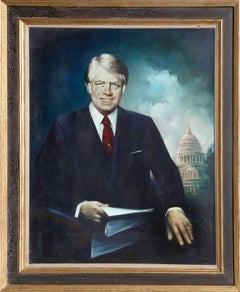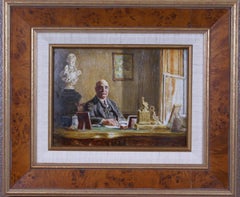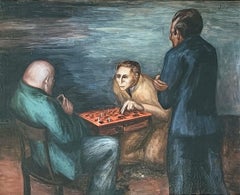Malcolm Parle Figurative Paintings
to
1
Overall Width
to
Overall Height
to
1
1
1
1
1
1
1
1
1
1
462
330
261
214
1
1
Artist: Malcolm Parle
Jimmy Carter, American Realist Oil Painting on Canvas by Malcolm Parle
By Malcolm Parle
Located in Long Island City, NY
A portrait of Jimmy Carter, painted in oil sometime before he took office as the 39th President of the United States. He is sitting in a chair with a handful of documents in his hand...
Category
1970s American Realist Malcolm Parle Figurative Paintings
Materials
Oil
Related Items
J.P. Morgan
Located in Storrs, CT
A 20th-century American School oil painting on board featuring American banker and financier J.P. Morgan (1837-1913) seated at his desk. Light streams throug...
Category
Mid-20th Century American Realist Malcolm Parle Figurative Paintings
Materials
Oil
Chess Players WPA Depression Era Mid-20th Century American Scene Realism Modern
By Mervin Jules
Located in New York, NY
Chess Players WPA Depression Era Mid-20th Century American Scene Realism Modern. Signed upper right and verso 8 x 10 inches oil on board.
BIO
The son of a men's haberdasher, Mervin ...
Category
1930s American Realist Malcolm Parle Figurative Paintings
Materials
Oil, Board
$6,800
H 10 in W 12 in D 2 in
Street of the Old Quarter British School signed Cade oil on canvas painting
Located in Barcelona, Barcelona
**Technical Sheet**
**Title:** "Street of the Old Quarter"
**Author:** British School, 19th Century
**Date:** 1892
**Technique:** Oil on canvas
**Dimensions:** 14.17 x 10.63 inc...
Category
1890s American Realist Malcolm Parle Figurative Paintings
Materials
Canvas, Oil
$837 Sale Price
41% Off
H 14.18 in W 10.63 in
Mid Century Seascape and Figural Original oil painting on Linen
By Robert Watson
Located in Soquel, CA
Mid Century Seascape and Figural Original oil painting on Linen 1956
Solitary figure on wharf by California artist Robert Watson, painted 1956 (1923 - 2004)The following, is from To...
Category
1950s American Realist Malcolm Parle Figurative Paintings
Materials
Linen, Oil
$3,720 Sale Price
20% Off
H 29 in W 44.75 in D 1.88 in
American School Portrait of a Child
Located in Astoria, NY
American School, Portrait of a Child with Red Tulip Flower, Oil on Canvas, circa 1900, illegibly signed "J. Hisnik(?)" and inscribed "N.Y." lower left, ebonized giltwood frame. Image...
Category
Late 19th Century American Realist Malcolm Parle Figurative Paintings
Materials
Canvas, Oil
1880s Figurative Sackett's Calvary Charge of the 9th New York Volunteers
Located in Soquel, CA
Late 19th century figurative painting of the battle of Trevilians Station and of the wounding of Colonel Sackett June 11, 1864. Oil on canvas in giltwood frame. Signed or notated ind...
Category
1880s American Realist Malcolm Parle Figurative Paintings
Materials
Linen, Oil, Stretcher Bars
$5,500
H 25.75 in W 41.75 in D 1.25 in
Doctor's Office. Mid-Century American Scene Oil Painting Youngstown, OH.
Located in Marco Island, FL
An anxious moment waiting to see the doctor is depicted by Clyde Singer in this quiet and still painting. Entitled Doctor's Office (1949), Singer paints a moment of anticipation and...
Category
1940s American Realist Malcolm Parle Figurative Paintings
Materials
Panel, Oil
Mid Century Figurative Portrait of a Boy with Toy Car
By Ralph Edward Joosten
Located in Soquel, CA
Realistic mid century portrait of a boy playing with an antique toy car by Ralph Joosten (American, 1928-2009). Signed "R. Joosten" in the lower left ...
Category
1960s American Realist Malcolm Parle Figurative Paintings
Materials
Canvas, Oil
$812 Sale Price
35% Off
H 24 in W 20 in D 0.75 in
"Auto Service" (2025) By Greg Gandy, Original Oil Painting
Located in Denver, CO
"Auto Service" (2025) is a striking handmade still-life oil painting by American realist Greg Gandy, depicting an older car in a bay at an auto service station.
Artist Bio:
Greg Ga...
Category
2010s American Realist Malcolm Parle Figurative Paintings
Materials
Oil, Panel
'Sketching Wisconsin' original oil painting, Signed
By John Steuart Curry
Located in Milwaukee, WI
John Steuart Curry
"Sketching Wisconsin," 1946
oil on canvas
31.13 x 28 inches, canvas
39.75 x 36.75 x 2.5 inches, frame
Signed and dated lower right
Overall excellent condition
Presented in a 24-karat gold leaf hand-carved wood frame
John Steuart Curry (1897-1946) was an American regionalist painter active during the Great Depression and into World War II. He was born in Kansas on his family’s farm but went on to study art in Chicago, Paris and New York as young man. In Paris, he was exposed to the work of masters such as Peter Paul Rubens, Eugène Delacroix and Jacques-Louis David. As he matured, his work showed the influence of these masters, especially in his compositional decisions. Like the two other Midwestern regionalist artists that are most often grouped with him, Grant Wood (American, 1891-1942) and Thomas Hart Benton (American, 1889-1975), Curry was interested in representational works containing distinctly American subject matter. This was contrary to the popular art at the time, which was moving closer and closer to abstraction and individual expression.
Sketching Wisconsin is an oil painting completed in 1946, the last year of John Steuart Curry’s life, during which time he was the artist-in-residence at the University of Wisconsin in Madison. The painting is significant in Curry’s body of work both as a very revealing self-portrait, and as a landscape that clearly and sensitively depicts the scenery of southern Wisconsin near Madison. It is also a portrait of the artist’s second wife, Kathleen Gould Curry, and is unique in that it contains a ‘picture within a picture,’ a compositional element that many early painting masters used to draw the eye of the viewer. This particular artwork adds a new twist to this theme: Curry’s wife is creating essentially the same painting the viewer is looking at when viewing Sketching Wisconsin.
The triangular composition of the figures in the foreground immediately brings focus to a younger Curry, whose head penetrates the horizon line and whose gaze looks out towards the viewer. The eye then moves down to Mrs. Curry, who, seated on a folding stool and with her hand raised to paint the canvas on the easel before her, anchors the triangular composition. The shape is repeated in the legs of the stool and the easel. Behind the two figures, stripes of furrowed fields fall away gently down the hillside to a farmstead and small lake below. Beyond the lake, patches of field and forest rise and fall into the distance, and eventually give way to blue hills.
Here, Curry has subverted the traditional artist’s self-portrait by portraying himself as a farmer first and an artist second. He rejects what he sees as an elitist art world of the East Coast and Europe. In this self-portrait he depicts himself without any pretense or the instruments of his profession and with a red tractor standing in the field behind him as if he was taking a break from the field work. Here, Curry’s wife symbolizes John Steuart Curry’s identity as an artist. Compared with a self-portrait of the artist completed a decade earlier, this work shows a marked departure from how the artist previously presented and viewed himself. In the earlier portrait, Curry depicted himself in the studio with brushes in hand, and with some of his more recognizable and successful canvases behind him. But in Sketching Wisconsin, Curry has taken himself out of the studio and into the field, indicating a shift in the artist’s self-conception.
Sketching Wisconsin’s rural subject also expresses Curry’s populist ideals, that art could be relevant to anyone. This followed the broad educational objectives of UW’s artist-in-residence program. Curry was appointed to his position at the University of Wisconsin in 1937 and was the first person to hold any such position in the country, the purpose of which was to serve as an educational resource to the people of the state. He embraced his role at the University with zeal and not only opened the doors of his campus studio in the School of Agriculture to the community, but also spent a great deal of time traveling around the state of Wisconsin to visit rural artists who could benefit from his expertise. It was during his ten years in the program that Curry was able to put into practice his belief that art should be meaningful to the rural populace. However, during this time he also struggled with public criticism, as the dominant forces of the art market were moving away from representation. Perhaps it was Curry’s desire for public acceptance during the latter part of his career that caused him to portray himself as an Everyman in Sketching Wisconsin.
Beyond its importance as a portrait of the artist, Sketching Wisconsin is also a detailed and sensitive landscape that shows us Curry’s deep personal connection to his environment. The landscape here can be compared to Wisconsin Landscape of 1938-39 (the Metropolitan Museum of Art), which presents a similar tableau of rolling hills with a patchwork of fields. Like Wisconsin Landscape, this is an incredibly detailed and expressive depiction of a place close to the artist’s heart. This expressive landscape is certainly the result of many hours spent sketching people, animals, weather conditions and topography of Wisconsin as Curry traveled around the state. The backdrop of undulating hills and the sweeping horizon, and the emotions evoked by it, are emphatically recognizable as the ‘driftless’ area of south-central Wisconsin. But while the Metropolitan’s Wisconsin Landscape conveys a sense of uncertainty or foreboding with its dramatic spring cloudscape and alternating bands of light and dark, Sketching Wisconsin has a warm and reflective mood. The colors of the foliage indicate that it is late summer and Curry seems to look out at the viewer approvingly, as if satisfied with the fertile ground surrounding him.
The landscape in Sketching Wisconsin is also revealing of what became one of Curry’s passions while artist-in-residence at UW’s School of Agriculture – soil conservation. When Curry was a child in Kansas, he saw his father almost lose his farm and its soil to the erosion of The Dust Bowl. Therefore, he was very enthusiastic about ideas from UW’s School of Agriculture on soil conservation methods being used on Wisconsin farms. In Sketching Wisconsin, we see evidence of crop rotation methods in the terraced stripes of fields leading down the hillside away from the Curry’s and in how they alternate between cultivated and fallow fields.
Overall, Sketching Wisconsin has a warm, reflective, and comfortably pastoral atmosphere, and the perceived shift in Curry’s self-image that is evident in the portrait is a positive one. After his rise to favor in the art world in the 1930’s, and then rejection from it due to the strong beliefs presented in his art, Curry is satisfied and proud to be farmer in this self-portrait. Curry suffered from high blood...
Category
1940s American Realist Malcolm Parle Figurative Paintings
Materials
Canvas, Oil
$652,500
H 39.75 in W 36.75 in D 2.5 in
Palace Bar
By Paul G. Oxborough
Located in Greenwich, CT
Signed upper right
Unframed dimensions: 21 x 28 inches
Framed dimensions: 28 1/2 x 36 1/2 inches
Paul G. Oxborough studied at Minneapolis College of Art and Design and Atelier Lesue...
Category
2010s American Realist Malcolm Parle Figurative Paintings
Materials
Linen, Oil
Jack Henderson, Circus
By Jack Henderson
Located in New York, NY
This painting is signed at the lower right. The frame adds a few inches to the size and was selected by the artist.
Jack Henderson (1931-1998) taught at the Art Students League for many years and had a studio in at 30 East 14th Street, New York City. In that building were many other artists including Henderson's teacher and long-time collaborator, Edward Laning. A Kansas City native, Henderson was the recipient of a Fulbright Fellowship and a Fellow of the American Academy in Rome. He continued the Miller/Laning tradition of travel to Italy to study the masters of the Renaissance and the goal of fine figure painting as the ultimate artistic achievement. A version of his monumental triptych, New York in Ruin, 1967, is in the collection of the New York Landmarks Commission. Work by Jack Henderson was shown at the Susan Teller Gallery...
Category
1960s American Realist Malcolm Parle Figurative Paintings
Materials
Oil
Malcolm Parle figurative paintings for sale on 1stDibs.
Find a wide variety of authentic Malcolm Parle figurative paintings available for sale on 1stDibs. You can also browse by medium to find art by Malcolm Parle in oil paint, paint and more. Not every interior allows for large Malcolm Parle figurative paintings, so small editions measuring 30 inches across are available. Customers who are interested in this artist might also find the work of Coby Whitmore, Paul Zimmerman, and William Gropper. Malcolm Parle figurative paintings prices can differ depending upon medium, time period and other attributes. On 1stDibs, the price for these items starts at $100,000 and tops out at $100,000, while the average work can sell for $100,000.


